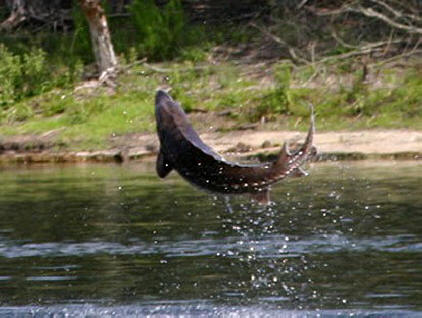http://en.wikipedia.org/wiki/Acipenser
It just so happens that the same species of sturgeon is a candidate to account for sightings of both Champ and the Loch Ness Monster, the New England Sea Serpent of the early 1800s and water monsters along the East Coast such as the Lake Norman Monster and the Altamaha-Ha. It goes without saying that this one kind of fish also cannot possibly account for ALL of the reports in these areas attributed to the local Water Monsters. This is also NOT the same kind of sturgeon that would be involved in sightings in Russia, Siberia, Alaska or Canada.

http://frontiersofzoology.blogspot.com/2012/08/giant-sturgeon-evidence-at-loch-ness.html
The sturgeon in question this time has a more exaggeratedly elongated snout and a more exaggeratedly toothed back pofile because the individual plates are larger. Record catches of this species are at 14 feet on both sides of the Atlantic. The Beluga or White sturgeon grows MUCH lasrger than this and allegedly as much as twice as long.

Fig. 1. Continental distribution of the European Atlantic sturgeon around 1750–1850. The distinction between the three functional groups of basins is made. Coastal catches reported at the extreme margins of the sturgeon distribution are displayed by black areas. The seven marine provinces are showed on the map following a grey scale. The Nile basin (Egypt) was truncated to offer better visualization of smaller features onto the map. Numbers refer to Supplementary information on spawning basins given in Table 1. The transitory basins – in alphabetical order – are: Arno, Bann, Barrow, Blackwater (Ireland, county Waterford), Bresle, Clyde (Scotland), Daugava, Dee (North West England), Dives, Eden (Scotland), Evros, Forth (Scotland), Foyle, Gota alv, Great Ouse, Guden, Jucar, Kemijoki, Lima, Loire, Mersey, Meuse, Minho, Neretva, Ombrone, Piave, Scheldt, Severn, Slaney, Somme, Struma, Tagliamento, Tagus, Tay, Thames, Torn alv, Towy, Trent (England), Tweed (Scotland), Tyne, Vjose, Vire, Volturno, Wye (Wales). If different rivers with the same name exist, country and county are given.
http://www.sciencedirect.com/science/article/pii/S0006320710002740
According to Adrian Shine the Loch Ness Monster Sturgeon is supposed to be the same species as the Baltic Sea type, This is the same species as the Atlantic sturgeon but wound up in a cul-de-sac by the expansion of the rival sturgeon species A. sturio.
Different populations inhabit areas North and South of this

Florida sturgeon leaping. This one came crashing into a woman on a boat
and broke her leg with the force News Story Here
Very large sturgeon washed ashore in Florida by a storm. Still an internet sensation.
Atlantic Sturgeon carcass washed up in St Lawrence River

http://frontiersofzoology.blogspot.com/2012/04/massachussets-bay-sturgeon-1819-and-mr.html











No comments:
Post a Comment
This blog does NOT allow anonymous comments. All comments are moderated to filter out abusive and vulgar language and any posts indulging in abusive and insulting language shall be deleted without any further discussion.